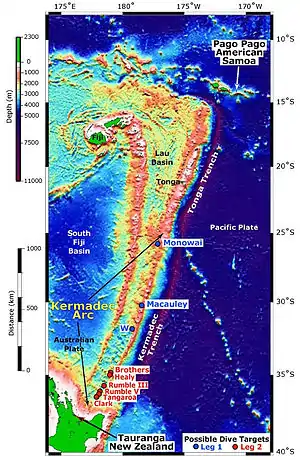Kermadec Trench
The Kermadec Trench is a linear ocean trench in the south Pacific Ocean. It stretches about 1,000 km (620 mi) from the Louisville Seamount Chain in the north (26°S) to the Hikurangi Plateau in the south (37°S), north-east of New Zealand's North Island.[1] Together with the Tonga Trench to the north, it forms the 2,000 km (1,200 mi)-long, near-linear Kermadec-Tonga subduction system, which began to evolve in the Eocene when the Pacific Plate started to subduct beneath the Australian Plate. Convergence rates along this subduction system are among the fastest on Earth, 80 mm (3.1 in)/yr in the north and 45 mm (1.8 in)/yr in the south.[2]

Geology
The Kermadec Trench is one of Earth's deepest oceanic trenches, reaching a depth of 10,047 metres (32,963 ft). Formed by the subduction of the Pacific Plate under the Indo-Australian Plate, it runs parallel with and to the east of the Kermadec Ridge and island arc. The Tonga Trench marks the continuation of subduction to the north.
The Kermadec Trench has a southern continuation in the turbidite-filled Hikurangi Trough, but a series of seamounts on the Australian Plate act as a dam and prevent this turbidity from reaching the sediment-starved Kermadec Trench. Debris from a larger subducted seamount probably dammed the trench from 2 Ma to 0.5 Ma and similar events probably redirected sediments in similar ways before that.[3]
Two oceanic plates meet at the Kermadec Trench which is located far from any larger landmass. Because of this, the Pacific Plate as well as the trench itself is only covered by c. 200 m (660 ft) of sediments. The trench is almost perfectly straight and its simple geometry is the result of the uniformity of the subducting sea-floor. This sea-floor formed at the extinct Osbourn Trough, located just north of the Louisville Seamount Chain. Abyssal hills on the subducting sea-floor are oriented perpendicular to the old spreading centre and the sea-floor is 72–80 Ma near the Louisville seamounts at the northern end and more than 100 Ma near Hikurangi Plateau at the southern end. There are no seamounts on the sea-floor near the Kermadec Trench except one sitting on the trench slope at 31.50°S 176.45°W which has been dated to 54.8±1.9 Ma.[1]
The Hikurangi Plateau formed part of the Ontong-Java-Manihiki-Hikurangi large igneous province (LIP) during the Ontong Java Event 120 Ma. The Manihiki Plateau is currently subducting under the southern part of the Kermadec Arc but most of it has already been subducted. The LIP-arc collision occurred 250 km (160 mi) north of its present location, but oblique plate convergence has migrated the subducted plateau southward.[4]
Fauna
In 2012, deep sea researchers discovered individuals of a species of giant amphipod at the trench's lowest depths.[5] Unlike most amphipods, which are approximately 2.5 cm (1 inch) long, this species reaches up to 34 cm (13 inches) in length, and are milky-white.[5]
The second-deepest fish, the hadal snailfish Notoliparis kermadecensis, is endemic to the trench and occupies a very limited depth range, 6,472 to 7,561 m (21,234 to 24,806 ft).[6]
A species of pearlfish, Echiodon neotes, has been caught in the Kermadec Trench at a depth of 8,200–8,300 m (26,900–27,200 ft). All other known pearlfishes live in the range 1,800–2,000 m (5,900–6,600 ft) and the presence of E. neotes at this depth remains unexplained.[7]
Nereus research submarine
In May 2014, the Nereus, an unmanned research submarine operated by the Woods Hole Oceanographic Institution (WHOI), imploded due to high pressure at a depth of 9,990 metres while exploring the Kermadec Trench.[8]
References
Notes
- Billen & Gurnis 2005, p. 9
- Stratford et al. 2015, p. 4
- Lewis, Collot & Lallem 1998, Abstract
- Timm et al. 2014, Abstract; p. 2
- Morelle, Rebecca (2 February 2012). "'Supergiant' crustacean found in deepest ocean". BBC News. Retrieved 13 May 2014.
- Yancey et al. 2014, Significance; Fig. 1
- Fujii et al. 2010
- "Nereus, unmanned research sub, suffers 'catastrophic implosion' nearly 10 kilometres underwater". National Post. Toronto. Associated Press. 12 May 2014. Retrieved 13 May 2014.
Bibliography
- Billen, M. I.; Gurnis, M. (2005). "Constraints on subducting plate strength within the Kermadec trench" (PDF). Journal of Geophysical Research: Solid Earth. 110 (B5). doi:10.1029/2004JB003308. Retrieved 9 April 2017.
- Fujii, T.; Jamieson, A. J.; Solan, M.; Bagley, P. M.; Priede, I. G. (2010). "A large aggregation of liparids at 7703 meters and a reappraisal of the abundance and diversity of hadal fish". BioScience. 60 (7): 506–515. doi:10.1525/bio.2010.60.7.6. Retrieved 29 April 2017.
- Lewis, K. B.; Collot, J. Y.; Lallem, S. E. (1998). "The dammed Hikurangi Trough: a channel‐fed trench blocked by subducting seamounts and their wake avalanches (New Zealand–France GeodyNZ Project)" (PDF). Basin Research. 10 (4): 441–468. doi:10.1046/j.1365-2117.1998.00080.x. Retrieved 29 April 2017.
- Stratford, W.; Peirce, C.; Paulatto, M.; Funnell, M.; Watts, A. B.; Grevemeyer, I.; Bassett, D. (2015). "Seismic velocity structure and deformation due to the collision of the Louisville Ridge with the Tonga-Kermadec Trench" (PDF). Geophysical Journal International. 200 (3): 1503–1522. doi:10.1093/gji/ggu475. Retrieved 16 April 2017.
- Timm, C.; Davy, B.; Haase, K.; Hoernle, K. A.; Graham, I. J.; de Ronde, C. E.; Woodhead, J.; Bassett, D.; Hauff, F.; Mortimer, N.; Seebeck, H. C.; Wysoczanski, R. J.; Caratori-Tontini, F.; Gamble, J. A. (2014). "Subduction of the oceanic Hikurangi Plateau and its impact on the Kermadec arc" (PDF). Nature Communications. 5: 4923. doi:10.1038/ncomms5923. PMID 25230110. Retrieved 9 April 2017.
- Yancey, P. H.; Gerringer, M. E.; Drazen, J. C.; Rowden, A. A.; Jamieson, A. (2014). "Marine fish may be biochemically constrained from inhabiting the deepest ocean depths". PNAS. 111 (12): 4461–4465. doi:10.1073/pnas.1322003111. PMC 3970477. PMID 24591588. Retrieved 29 April 2017.
External links
- "Kermadec Trench". Woods Hole Oceanographic Institution. Retrieved 9 April 2017. An animation of a 3D model of the Kermadec Trench